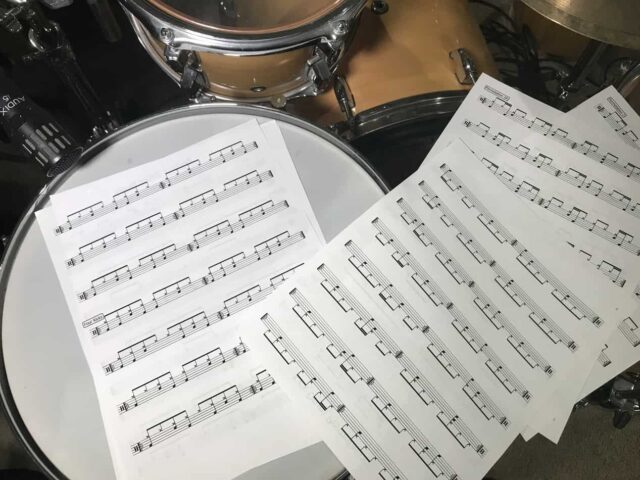
Before diving into the intricacies of creating drum tracks, it’s crucial to familiarize ourselves with some basic drumming terminology. By understanding essential terms and concepts, you will be better equipped to communicate your ideas and collaborate effectively with drummers. Let’s explore a few key terms:
- Kick Drum (Bass Drum) ─ This is the largest drum in a drum kit, played with a foot pedal, and provides the low-frequency foundation of the beat.
- Snare Drum ─ This is typically placed between the drummer’s legs and produces a sharp, distinctive sound. It’s played with drumsticks and adds a strong accent to the rhythm.
- Hi-Hat ─ Consisting of two cymbals that open and close together, the hi-hat is played with drumsticks or by using a foot pedal. It provides a continuous, rhythmic pattern and adds texture to the beat.
- Tom-Toms ─ They come in various sizes and are usually mounted on the drum kit. They provide melodic and rhythmic elements to the drumming.
Selecting Drum Samples ─ 4 Tips for Choosing the Right Sounds

Drum samples are pre-recorded sounds of individual drum hits or complete kits that can be triggered and sequenced within a digital audio workstation (DAW). Here are some tips to help you choose the right drum samples:
- Genre considerations ─ Different genres have distinct drumming styles and sounds. Research the genre you’re working in and listen to existing tracks to understand the common sounds used. This will guide you in selecting appropriate samples.
- Sound quality ─ Look for high-quality samples that sound authentic and realistic. Poorly recorded or low-quality samples can hinder the overall impact of your drum tracks.
- Sample variation ─ Choose drum samples that offer a range of dynamics and articulations. This will allow you to create more expressive and dynamic tracks.
- Layering options ─ Opt for samples that can be easily layered to create unique sounds and add depth to your tracks.
Looking for top-notch drum loops? Visit The Sample Lab and discover an incredible selection of free drum loop samples.
Constructing a Drum Pattern ─ Step-by-Step Guide to Building Beats
Now that you have your samples selected, it’s time to construct a drum pattern. This pattern is a sequence of drum hits arranged in a specific rhythm. Here’s a step-by-step guide to help you build your beats:
- Start with the kick and snare ─ Begin by programming the kick and snare drum hits. These two elements form the foundation of your pattern and establish the groove.
- Add the Hi-Hat ─ Once you have a solid kick and snare pattern, incorporate the hi-hat hits. Experiment with different patterns and note placements to create variations and add movement
- Introduce the toms and cymbals ─ After establishing the kick, snare, and hi-hat pattern, it’s time to incorporate the toms and cymbals. Use the toms to add fills and additional rhythmic elements, while the cymbals can be used for accents and crashes.
- Experiment with velocity ─ To make your pattern sound more natural and dynamic, adjust the velocity of each drum hit. Varying the velocity will mimic the human touch of a drummer, creating a more realistic and expressive sound.
- Quantization and swing ─ Quantization refers to aligning the drum hits to a grid, ensuring precise timing. However, adding a slight swing or groove to your pattern can make it feel more organic. Experiment with different levels of swing to find the right balance for your track.
- Iteration and refinement ─ Creating a compelling pattern often requires iteration and refinement. Don’t be afraid to experiment, make adjustments, and listen critically to how the pattern interacts with the other elements in your composition. Trust your ears and keep refining until you achieve the desired result.
Adding Variation ─ Techniques to Make Drum Tracks Interesting and Dynamic

To prevent your drum tracks from sounding repetitive and monotonous, it’s essential to incorporate variation. Here are some techniques to make your tracks interesting and dynamic:
- Ghost notes ─ Ghost notes are soft, subtle drum hits that add depth and complexity to the rhythm. Experiment with adding ghost notes to the snare or hi-hat patterns to create intricate rhythms.
- Drum fills ─ These are short rhythmic phrases that occur between sections of a song to add excitement and transition smoothly. Incorporate drum fills sparingly to maintain interest and provide a sense of progression in your tracks.
- Accentuated hits ─ By emphasizing certain drum hits, such as the snare or crash cymbal, you can create impactful moments in your tracks. Use accentuated hits strategically to highlight important sections or build anticipation.
- Pattern variation ─ Introduce subtle changes to your patterns throughout the track. This can involve altering the kick or snare pattern, adding or removing drum elements, or changing the placement of certain hits. These variations will keep the listener engaged and prevent predictability.
Programming Realistic Drum Performances ─ Tips for Achieving Natural-Sounding Rhythms

When programming drum tracks, it’s essential to strive for realism and natural-sounding rhythms. Here are some tips to help you achieve a more authentic drum performance:
- Humanize timing ─ Perfectly quantized drum hits can sound robotic. Humanize the timing by slightly adjusting the placement of each hit. Introduce subtle variations to mimic the natural fluctuations in timing that occur when a drummer plays.
- Use velocity modulation ─ Emulate the dynamics of a live drummer by modulating the velocity of your hits. This means varying the strength or intensity of each hit to create a more expressive performance. Incorporate accents and ghost notes by adjusting the velocity accordingly.
- Add imperfections ─ Drummers don’t always hit every drum perfectly. Introduce intentional imperfections by programming slight inconsistencies in hit strength, timing, or even unintentional ghost notes. These imperfections contribute to the organic feel of your drum tracks.
- Experiment with articulations ─ Drummers use different techniques to produce a wide range of sounds from their drums. Explore different articulations such as rimshots, flams, or open/closed hi-hats to add nuance and realism to your tracks.
- Utilize MIDI controllers ─ If you have access to MIDI controllers, such as drum pads or electronic drum kits, use them to capture your performance in real-time. This allows for a more natural and expressive drumming experience, as you can play and record the drum parts as if you were playing a physical drum kit.
In conclusion, creating drum tracks as a non-drummer may seem challenging at first, but with the right knowledge and techniques, you can add compelling and dynamic rhythms to your music. So, dive in, experiment, and let your creativity take flight with the rhythmic possibilities of drum tracks.







